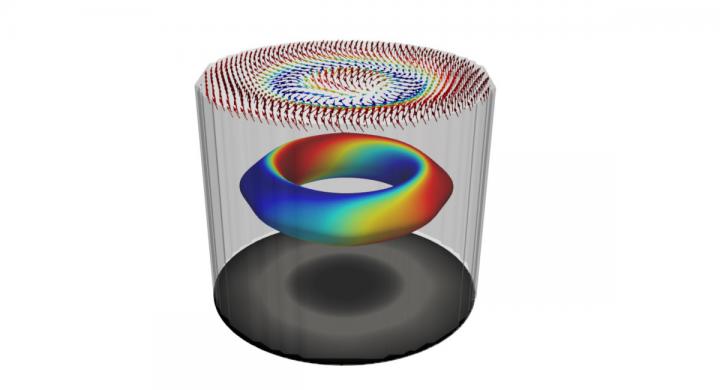Pioneering study co-led by Berkeley Lab has significance for next-gen information technologies

Credit: Peter Fischer and Frances Hellman/Berkeley Lab
A decade ago, the discovery of quasiparticles called magnetic skyrmions provided important new clues into how microscopic spin textures will enable spintronics, a new class of electronics that use the orientation of an electron’s spin rather than its charge to encode data.
But although scientists have made big advances in this very young field, they still don’t fully understand how to design spintronics materials that would allow for ultrasmall, ultrafast, low-power devices. Skyrmions may seem promising, but scientists have long treated skyrmions as merely 2D objects. Recent studies, however, have suggested that 2D skyrmions could actually be the genesis of a 3D spin pattern called hopfions. But no one had been able to experimentally prove that magnetic hopfions exist on the nanoscale.
Now, a team of researchers co-led by Berkeley Lab has reported in Nature Communications the first demonstration and observation of 3D hopfions emerging from skyrmions at the nanoscale (billionths of a meter) in a magnetic system. The researchers say that their discovery heralds a major step forward in realizing high-density, high-speed, low-power, yet ultrastable magnetic memory devices that exploit the intrinsic power of electron spin.
“We not only proved that complex spin textures like 3D hopfions exist – We also demonstrated how to study and therefore harness them,” said co-senior author Peter Fischer, a senior scientist in Berkeley Lab’s Materials Sciences Division who is also an adjunct professor in physics at UC Santa Cruz. “To understand how hopfions really work, we have to know how to make them and study them. This work was possible only because we have these amazing tools at Berkeley Lab and our collaborative partnerships with scientists around the world,” he said.
According to previous studies, hopfions, unlike skyrmions, don’t drift when they move along a device and are therefore excellent candidates for data technologies. Furthermore, theory collaborators in the United Kingdom had predicted that hopfions could emerge from a multilayered 2D magnetic system.
The current study is the first to put those theories to test, Fischer said.
Using nanofabrication tools at Berkeley Lab’s Molecular Foundry, Noah Kent, a Ph.D. student in physics at UC Santa Cruz and in Fischer’s group at Berkeley Lab, worked with Molecular Foundry staff to carve out magnetic nanopillars from layers of iridium, cobalt, and platinum.
The multilayered materials were prepared by UC Berkeley postdoctoral scholar Neal Reynolds under the supervision of co-senior author Frances Hellman, who holds titles of senior faculty scientist in Berkeley Lab’s Materials Sciences Division, and professor of physics and materials science and engineering at UC Berkeley. She also leads the Department of Energy’s Non-Equilibrium Magnetic Materials (NEMM) program, which supported this study.
Hopfions and skyrmions are known to co-exist in magnetic materials, but they have a characteristic spin pattern in three dimensions. So, to tell them apart, the researchers used a combination of two advanced magnetic X-ray microscopy techniques – X-PEEM (X-ray photoemission electron microscopy) at Berkeley Lab’s synchrotron user facility, the Advanced Light Source; and magnetic soft X-ray transmission microscopy (MTXM) at ALBA, a synchrotron light facility in Barcelona, Spain – to image the distinct spin patterns of hopfions and skyrmions.
To confirm their observations, the researchers then carried out detailed simulations to mimic how 2D skyrmions inside a magnetic device evolve into 3D hopfions in carefully designed multilayer structures, and how these will appear when imaged by polarized X-ray light.
“Simulations are a hugely important part of this process, enabling us to understand the experimental images and to design structures that will support hopfions, skyrmions, or other designed 3D spin structures,” Hellman said.
To understand how hopfions will ultimately function in a device, the researchers plan to employ Berkeley Lab’s unique capabilities and world-class research facilities – which Fischer describes as “essential for carrying out such interdisciplinary work” – to further study the quixotic quasiparticles’ dynamical behavior.
“We have known for a long time that spin textures are almost inevitably three dimensional, even in relatively thin films, but direct imaging has been experimentally challenging,” said Hellman. “The evidence here is exciting, and it opens doors to finding and exploring even more exotic and potentially significant 3D spin structures.”
###
Co-authors with Fischer and Hellman include David Raftrey, Ian T.G. Campbell, Selven Virasawmy, Scott Dhuey, and Rajesh V. Chopdekar of Berkeley Lab; Aurelio Hierro-Rodriguez of the University of Oviedo, and Andrea Sorrentino, Eva Pereiro, and Salvador Ferrer of the ALBA Synchrotron, Spain.
The Advanced Light Source and Molecular Foundry are DOE Office of Science user facilities at Berkeley Lab.
This work was supported by the U.S. Department of Energy Office of Science.
Founded in 1931 on the belief that the biggest scientific challenges are best addressed by teams, Lawrence Berkeley National Laboratory and its scientists have been recognized with 14 Nobel Prizes. Today, Berkeley Lab researchers develop sustainable energy and environmental solutions, create useful new materials, advance the frontiers of computing, and probe the mysteries of life, matter, and the universe. Scientists from around the world rely on the Lab’s facilities for their own discovery science. Berkeley Lab is a multiprogram national laboratory, managed by the University of California for the U.S. Department of Energy’s Office of Science.
DOE’s Office of Science is the single largest supporter of basic research in the physical sciences in the United States, and is working to address some of the most pressing challenges of our time. For more information, please visit energy.gov/science.
Media Contact
Theresa Duque
[email protected]
Original Source
https:/
Related Journal Article
http://dx.




